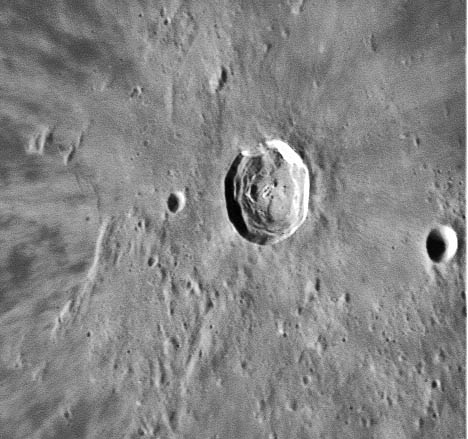Difference between revisions of "May 1, 2005"
| Line 12: | Line 12: | ||
</table> | </table> | ||
<table width="80%" border="0" align="center" cellpadding="8"> | <table width="80%" border="0" align="center" cellpadding="8"> | ||
| − | <tr><td><div align="center" class="main_sm">Image Credit: [mailto:starman2@charter.net Wes Higgins]</p> | + | <tr><td><div align="center" class="main_sm"><p>Image Credit: [mailto:starman2@charter.net Wes Higgins]</p> |
</div></td> | </div></td> | ||
</tr> | </tr> | ||
| Line 21: | Line 21: | ||
<p align="left">Rayed craters are rayless at low illuminations, but this view of Kepler is intermediate between low and high so that both the topography and rays are visible. Kepler itself is a small (32 km diameter) and young complex crater.Its walls have collapsed and slid toward the floor, piling up both amorphous mounds and discontinous terraces. At the center of a small flat floor are a handful of central peaks. Keplers ray system differs from Tycho and some other craters in that at Kepler the rays emerge from a large bright area - perhaps 3-4 times the diameter of the crater; this seems to be an area completely covered by rays. The rubbly terrain that Kepler and its close-in rays cover is ejecta from the Imbrium basin-forming impact.</p> | <p align="left">Rayed craters are rayless at low illuminations, but this view of Kepler is intermediate between low and high so that both the topography and rays are visible. Kepler itself is a small (32 km diameter) and young complex crater.Its walls have collapsed and slid toward the floor, piling up both amorphous mounds and discontinous terraces. At the center of a small flat floor are a handful of central peaks. Keplers ray system differs from Tycho and some other craters in that at Kepler the rays emerge from a large bright area - perhaps 3-4 times the diameter of the crater; this seems to be an area completely covered by rays. The rubbly terrain that Kepler and its close-in rays cover is ejecta from the Imbrium basin-forming impact.</p> | ||
<blockquote> | <blockquote> | ||
| − | <p align="right">— [mailto:tychocrater@yahoo.com Chuck Wood]</blockquote> | + | <p align="right">— [mailto:tychocrater@yahoo.com Chuck Wood]</p></blockquote> |
<p align="left"><b>Technical Details:</b><br> | <p align="left"><b>Technical Details:</b><br> | ||
Starmaster 18" Newtonian + DMK-21FO4 camera, 30FPS, stack of 660 frames from 2100.</p> | Starmaster 18" Newtonian + DMK-21FO4 camera, 30FPS, stack of 660 frames from 2100.</p> | ||
| Line 27: | Line 27: | ||
[[April_30,_2004|Lunar Orbiter III View]] | [[April_30,_2004|Lunar Orbiter III View]] | ||
<br>Rukl Plate 30 | <br>Rukl Plate 30 | ||
| + | </p> | ||
<p align="left"><b>Tomorrow's LPOD: </b> A Perfect LPOD Image</p> | <p align="left"><b>Tomorrow's LPOD: </b> A Perfect LPOD Image</p> | ||
</tr> | </tr> | ||
Revision as of 21:19, 17 January 2015
Rayless Crater
Image Credit: Wes Higgins |
|
Rayless Crater Rayed craters are rayless at low illuminations, but this view of Kepler is intermediate between low and high so that both the topography and rays are visible. Kepler itself is a small (32 km diameter) and young complex crater.Its walls have collapsed and slid toward the floor, piling up both amorphous mounds and discontinous terraces. At the center of a small flat floor are a handful of central peaks. Keplers ray system differs from Tycho and some other craters in that at Kepler the rays emerge from a large bright area - perhaps 3-4 times the diameter of the crater; this seems to be an area completely covered by rays. The rubbly terrain that Kepler and its close-in rays cover is ejecta from the Imbrium basin-forming impact. Technical Details: Related Links: Tomorrow's LPOD: A Perfect LPOD Image |
|
Author & Editor: Technical Consultant: Contact Translator: A service of: |
COMMENTS?
Register, and click on the Discussion tab at the top of the page.




